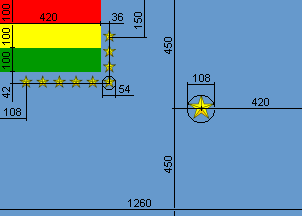Željko Heimer, 11 Mar 2001

Last modified: 2006-03-18 by antonio martins
Keywords: civil ensign | irredentism | naval ensign | bolivia | sleeve patch |
Links: FOTW homepage |
search |
disclaimer and copyright |
write us |
mirrors

The famous naval ensign of Bolivia - blue ensign with the
national flag in canton surrounded by 9 small
stars on two inner sides and one bigger star in lower fly.
Album 2000 [pay00] says
![]() .
The light blue field of the flag is approximated in Album
2000 with Pantone Process Blue.
.
The light blue field of the flag is approximated in Album
2000 with Pantone Process Blue.
Željko Heimer, 11 Mar 2001
The Naval Ensign was adopted by a Decreto Supremo of 13
April 1966, and the colour of the field is therein described as
azul celeste.
Christopher Southworth, 15 May 2004
The ensign is actually used on Lake Titicaca.
Armand du Payrat, 03 Feb 2002
Not just Lake Titicaca but something like 10 000 miles of
river as well, according to Jane’s Fighting Ships
[jfs] (online edition). The Bolivian Navy
has 6659 men and 73 vessels ranging from 3-man river patrol boats to seven
logistic support boats and 11 river transports.
Joe McMillan, 03 Feb 2002
All the photos I have seen of the patrol boats on Lake Titicana feature
the state flag. Maybe the “naval
ensign” is more a ceremonial flag?
Miles Li, 04 Feb 2002
Jane’s [jfs] has three color
pictures of the Bolivian Navy in which flags are visible and in each case
the only flag flown is the regular Bolivian tricolor, not the naval ensign.
There are, as I recall, eight different boats shown among these three
photographs.
Joe McMillan, 03 Feb 2002
Every TV documentary I have seen related with Lake Titicaca shows a
patrol-boat with the naval ensign. I won’t be surprised if it were
a kind of non-official prerequisite to make images there.
Ivan Sache, 03 Feb 2002
The red-yellow-green civil flag of Bolivia is authorized for use as a civil ensign by Bolivian registered shipping, despite the fact that Bolivia has no coastline. Fair enough. But Bolivia also has a naval ensign — which normally would imply a coastline and a navy to defend it.
The flag is light blue with a Bolivian flag in the canton. There are nine yellow stars below and to the right of the canton and a larger tenth star in the fly.
This is a good example of a flag being used to maintain a geopolitical claim. Bolivia had access to the Pacific until 1884 and getting it back has been one of the dominant trends of Bolivian domestic and international politics ever since. To cut a long and complicated story short, in 1879 Chile declared war on Peru and Bolivia which had, in alliance, seized various territories, including valuable nitrate mines, along the Pacific coast. The Bolivians and Peruvians lost. In 1904 the Chilean control over the coastal access lost by Bolivia was confirmed by treaty, the deal being that Bolivia should have access to the port of Arica via a railway to be built at Chilean expense. This was completed in 1913, but the Bolivians renewed their territorial claim in 1918. In 1932, Bolivia tried to gain access to the Atlantic by going to war with Paraguay. (Quite how this was supposed to work, given that Paraguay is itself landlocked, is something I’ve not seen satisfactorily explained.) Anyway, Bolivia lost disastrously, and Paraguay annexed about a third of Bolivia’s territory. In 1962 the whole business flared up again and Bolivia broke off diplomatic relations with Chile. In 1975, Chile suggested a land swap as part of a package which would give Bolivia sea access, and a year later Peru came up with further suggestions. The stalemate continues, although discussions were held between Chile and Bolivia in 1991. The meeting, held between 18-22 March, coincided with Bolivia’s «Day of the Sea» the timing and symbolism of which were fairly obvious.
The 9 small stars on the Bolivian naval flag represent the current 9 departments of Bolivia while the tenth symbolizes Bolivia’s irredentist claim for sea access.
Stuart Notholt, 11 Feb 1996
Bolivia, now landlocked, still has a navy (on the Titicaca lake),
with officers and admirals indeed, and flying a
naval ensign to maintain the hope of getting back the maritime Atacama
department, annexed by Chile after a border war. Bolivia also has a flag
for this lost departement, Litoral de Atacama.
Ivan Sache, 03 Feb 1998, and
Santiago Dotor, 05 Feb 1999

The ratio of this flag is quoted in
[smi80] as ≅3:4,
Album [pay00]
says 3:4 exactly, Shipmate Chart
[vdv00] have it as
2:3 and considerably larger canton.
Željko Heimer, 11 Mar 2001
Correction nº2 of the Album 2000
[pay02] shows a ratio of 5:7
and both this ratio and the specification were taken from a construction
diagram drawn up by me from an official model sent by the Bolivian
Ambassador to London (Jaime A. Quiroga Matos) on 25 May 2001 (and
forwarded to both Armand and Željko).
Christopher Southworth, 15 May 2004

I spent my last holiday in Bolivia and brought from there a flag,
which Bolivian navy soldiers wear on there left arm. It looks a little
bit different from the Bolivian Naval flag.
Jan-Patrick Fischer, 17 Feb 2001
The main difference is the wording "BOLIVIA" in the
lower hoist — all the other diffrences (shade of blue, exact
position of the stars, size of the canton et c.) may be nothing
more that meaningless variations.
António Martins, 28 Feb 2002